Reaction to Fire Testing for Expanded Polystyrene (EPS)
Reaction to Fire Testing is a critical aspect of ensuring fire safety in buildings, especially when it comes to materials like Expanded Polystyrene (EPS). EPS is widely used as insulation and cladding in construction due to its excellent thermal insulating properties. However, the potential for flaming combustion under certain conditions necessitates stringent testing to assess how this material behaves during a fire.
The purpose of reaction to fire tests is to evaluate the ignition propensity, flame spread rate, smoke production, heat release rates, and other parameters that indicate the material's resistance to fire. These tests are crucial in determining whether a material complies with relevant fire safety regulations and standards such as ISO 11925 series which includes ISO 11925-2, the specific test for EPS.
The testing process involves exposing a standard size specimen of EPS to controlled fire conditions in an apparatus that simulates real-world scenarios. The apparatus used typically includes a vertical furnace where specimens are exposed to flames and heat. The behavior is observed over time, and data on flame spread, smoke density, and other factors are recorded.
The results of these tests are essential for architects, engineers, and building owners as they provide critical information about the safety performance of EPS in various applications. Compliance with fire safety standards can also impact insurance premiums, regulatory approvals, and public confidence in a project’s overall safety.
Understanding the parameters that influence reaction to fire testing is vital for quality assurance teams and R&D engineers working on building materials. Factors such as specimen size, environmental conditions during testing, and the type of flame used (e.g., open flame vs. gas burner) can significantly affect test results. It’s important to ensure that specimens are prepared correctly according to standard procedures to avoid discrepancies in outcomes.
Moreover, the impact of EPS on overall building fire safety is not just about its own properties but also how it interacts with other materials and systems within a structure. For instance, EPS used as cladding must be evaluated for its ability to prevent or slow down fire spread from one part of a building to another.
Fire testing laboratories like ours are equipped with state-of-the-art facilities that adhere strictly to international standards ensuring accurate and repeatable results. Our expert team ensures that each test is conducted rigorously, providing reliable data that helps stakeholders make informed decisions regarding the use of EPS in their projects.
Why It Matters
The importance of reaction to fire testing for Expanded Polystyrene (EPS) cannot be overstated. Fire safety is a paramount concern in modern construction, and ensuring that materials like EPS meet stringent standards helps protect lives and property from the devastating effects of fires.
- Public Safety: Ensuring EPS meets rigorous fire testing criteria reduces the risk of rapid fire spread, which can save countless lives during emergencies.
- Regulatory Compliance: Meeting international standards such as ISO 11925-2 ensures that your project complies with local and national regulations, avoiding potential legal issues and fines.
- Sustainable Construction Practices: By choosing EPS that passes fire safety tests, builders contribute to more sustainable construction practices by using materials known to perform reliably under extreme conditions.
Failure in meeting these standards can lead to significant financial losses due to project delays or even total reconstruction. It also undermines the reputation of both the builder and the material supplier. Thus, investing in comprehensive fire testing early on is a prudent measure that pays dividends long-term.
In summary, the stakes are high when it comes to fire safety, especially for materials used in critical areas such as insulation and cladding. Ensuring compliance through thorough reaction to fire testing not only enhances public safety but also supports sustainable construction practices and regulatory compliance.
Industry Applications
- Commercial Buildings: EPS is commonly used in commercial buildings for insulation of walls, roofs, and floors. Fire testing ensures that these installations are safe even under extreme conditions.
- Sporting Venues: Many sporting venues incorporate EPS into their design for insulation purposes. Reliable fire testing guarantees the safety of thousands of spectators during events.
- Residential Properties: Homes and apartment blocks use EPS as cladding, which must pass rigorous fire tests to prevent catastrophic failures in case of a fire outbreak.
- Healthcare Facilities: Hospitals and clinics rely on EPS for insulation due to its thermal properties. Ensuring these materials are safe is crucial given the high occupancy rates and critical nature of healthcare environments.
The consistent use of compliant EPS in various sectors highlights the universal need for fire safety testing across industries. By adhering to established standards, we contribute to a safer built environment where people can live, work, play, and heal without fear.
Quality and Reliability Assurance
The quality and reliability of EPS materials are directly influenced by the results obtained from reaction to fire testing. This testing process plays a pivotal role in ensuring that EPS consistently meets or exceeds specified performance criteria.
- Consistent Performance: Repeated testing helps identify any variations in material properties, allowing manufacturers to fine-tune their processes for consistent quality output.
- Longevity of Materials: Reliable fire tests ensure that EPS can withstand harsh environmental conditions over extended periods without compromising its structural integrity or fire resistance capabilities.
- Predictable Behavior Under Fire Conditions: By simulating real-world scenarios during testing, we provide data that predicts how EPS will behave in actual fires, enhancing overall building safety measures.
Our laboratory uses advanced instrumentation and follows strict protocols to conduct these tests. This ensures that the results are accurate, reproducible, and reflective of true performance under fire conditions. The reliability of our testing services is bolstered by adherence to international standards like ISO 11925-2, which guarantees consistency across different jurisdictions.
The insights gained from such rigorous testing allow stakeholders—from manufacturers to end-users—to make informed decisions that prioritize safety and compliance. Ultimately, reliable fire testing enhances the trustworthiness of EPS products in the marketplace, contributing to a safer built environment for all.





